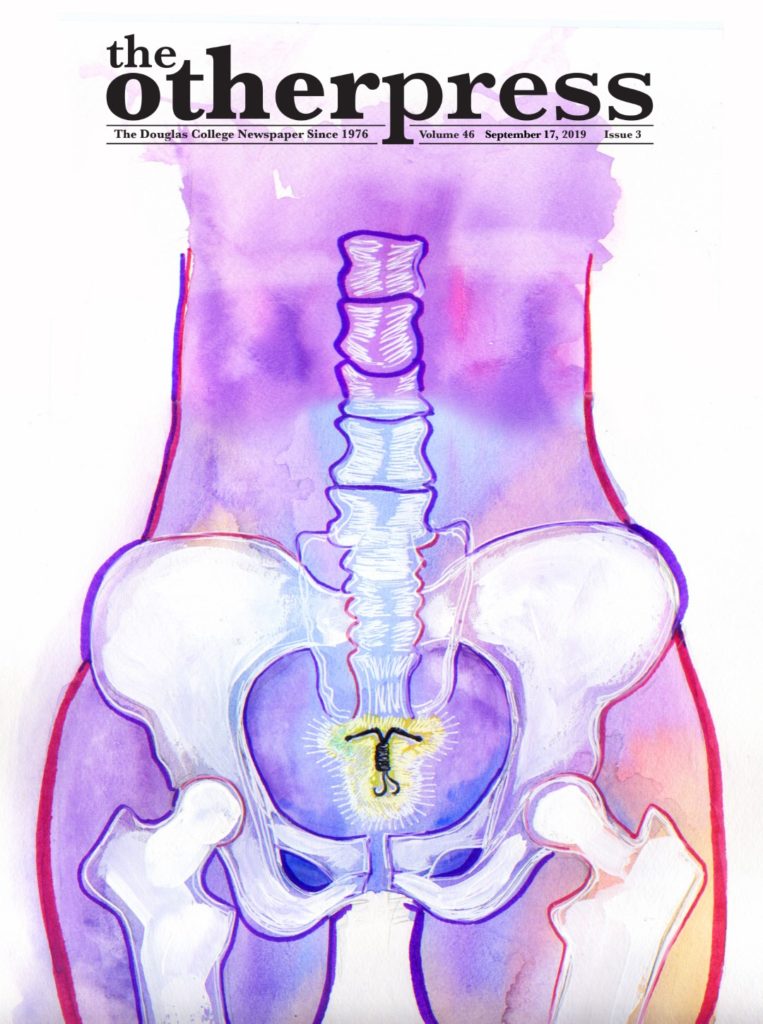
Cover design by Lauren Kelly
Intrauterine experiences
By Jessica Berget, Editor-in-Chief & Janis McMath, Assistant Editor
I love my IUD, but I also hate my IUD.
I got mine about three years ago. After trying the pill as my first contraceptive for about a year and having the worst time with it, I knew I needed to try something different. I heard a lot about this alternative birth control from a walk-in-clinic doctor, and from my friend who also had one.
Ever since getting my IUD, I’ve never had to worry about it. I stopped getting my period altogether, I get very minimal to no cramping, and often forget I have it at all.
Until I get a nagging cramp in my pelvic region and remember that I have a foreign metal stick shoved inside my uterus. Until I remember the day I got mine put in for the first time and how I felt like throwing up knowing what was about to be done to me, and how loudly I yelled “FUCK” in the family doctor’s office during the procedure. Until I remember my doctor telling me it’s moved out of its usual spot and that it will be painful and difficult to remove when the time comes. Until I remember in a couple years, I will have to have it torn out of me and then another one put back in again on the same day. Then, I hate my IUD.
An Intrauterine history
What exactly is an IUD though, and how does it prevent pregnancy? An IUD is a small t-shaped device that is put inside a woman’s uterus. There are two types: The copper and the hormonal such as Mirena, Jaydess, and Kyleena. With the copper IUD, the copper serves as a spermicide which prevents the egg from fertilizing. The hormonal IUD releases a hormone in the uterus that makes the mucus in your cervix thicker, making it harder for sperm to get to the egg. They are the most effective birth control method varying from 99 percent to 99.8 percent effectiveness.
People think of IUDs as a relatively new method of birth control, but they’ve been around for a long time. The copper IUD we use today hit the birth control scene back in 1962. Intrauterine devices were seen as a safe form of birth control until around the ‘70s, when one guy ruined it for everyone else.
The Dalkon Shield was a device that was on the market in the ‘70s and ‘80s. It was so popular that at one point, physicians prescribed it to over two million women in the US. However, it was poorly designed and not well-tested. After several years, over 200,000 women claimed that the device had given them serious medical conditions such as pelvic inflammatory disease, miscarriage, and loss of fertility. On top of that, there were 18 reported deaths caused by the shield. Because of this, popularity of intrauterine devices decreased, and for a while, people opted for oral contraceptives instead.
IUD’s are now an increasingly popular form of birth control. According to an article by the Star, prescriptions for the hormonal IUDs have “increased 46 percent from 116,478 in 2011 to 170,061 in 2015.” I think it’s safe to say almost five years later that those numbers have steadily increased. The switch to this contraceptive may be because of its low maintenance and high effectiveness rating at 99 percent.
Experiment with different types of IUDs to see what is best for you
When I was first trying to decide what type of birth control was right for me, I found IUDs appealing because they require no maintenance aside from a check-up appointment shortly after receiving it. It is truly a “set it and forget it” type of birth control.
While my current hormonal IUD has been a dream, my prior experience with the copper IUD was the complete opposite. According to Every Woman’s Health Centre (a Vancouver clinic), non-hormonal IUDs (also known as copper IUDs) have side effects that should only last about three to four months. I experienced the side effect of extremely painful cramps for a full year while hoping they would eventually go away. If I was standing on transit and a cramp came, I would have to squat and curl up in a ball near the floor. The pain was extreme at times to say the least.
Don’t let my horror story prevent you from getting a copper IUD though. It is a disadvantage that the copper IUD may consistently increase menstrual bleeding by 10 to 20 percent (according to the Vancouver Island Women’s Clinic) but that does not happen to everyone. Many use the copper option without issue and can even have it for up 10 years. In comparison, most hormonal IUDs sold in Vancouver last up to 5 years.
The copper IUD is good for those looking to pay a lower price too. In Vancouver, the 10-year typically goes for $80 and the hormonal IUD options are about $400. Remember that everyone’s body reacts differently to each IUD so make sure to not give up if one type isn’t for you.
Was it worth it?
The pain of getting one put in is too much for some people to bear, especially if you’ve never had a procedure down there before. When I went to get my IUD put in a couple years ago, in my feverish fear of the pain I heard accompanied the procedure, I looked up other women’s experiences of their IUD placement. One review likened it to getting tased in the vagina, which was not far off from my own experience. When I told this to my doctor after getting it put in, he laughed and said, “And you still came in!?”
Yes, I did, and I will gladly get tased in the vagina again. Because as horrible as it is getting it in, it beats all other forms of birth control on the market in terms of maintenance, effectiveness, and side effects. The pill gave me migraines so intense that they forced me to turn off all the lights, close my binds tight, and sob myself to sleep. The Depo-Provera shot scares me and isn’t as effective (about 94 percent in terms of real-life use). The other alternatives are either too high maintenance, or just aren’t appealing to me at all.
Sometimes, I hate my IUD. But then I remember the alternatives I have, and I realize it’s the best birth control method my uterus is going to get—pain and all. There is no perfect birth control method, but in my experience, and despite all the pain that accompanies the procedure, the IUD is probably the closest we’ll get thus far. Unless they come out with a birth control for men.


